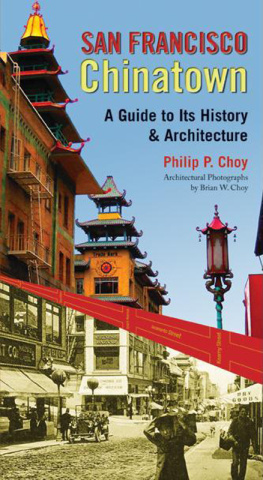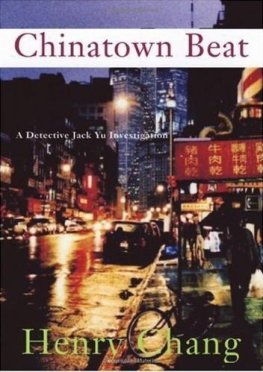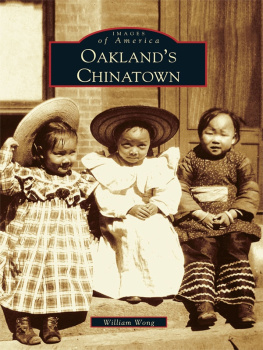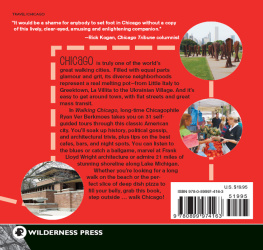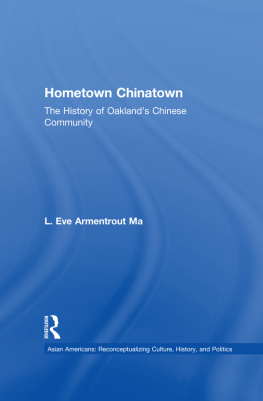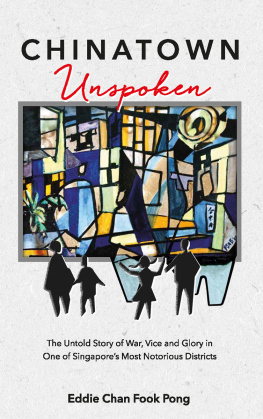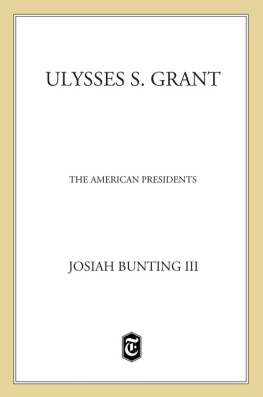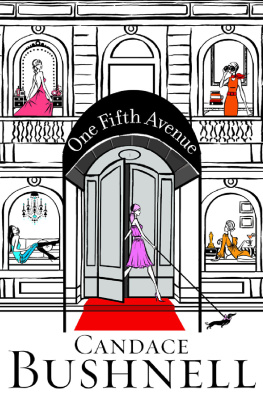SAN FRANCISCO
Chinatown
A Guide to Its History
and Architecture
Philip P. Choy
Architectural Photographs
by Brian W. Choy

City Lights San Francisco
Copyright 2012 Philip P. Choy
All Rights Reserved
Library of Congress Cataloging-in-Publication Data
Choy, Philip P.
San Francisco Chinatown : a guide to its history and architecture / Philip P. Choy.
p. cm.
ISBN 978-0-87286-540-2
1. Chinatown (San Francisco, Calif.)Tours. 2. Chinatown (San Francisco, Calif.)History. 3. Chinatown (San Francisco, Calif.)Description and travel. 4. Chinese AmericansCaliforniaSan Francisco. 5. Historic sitesCaliforniaSan Francisco. 6. San Francisco (Calif.)Tours. 7. San Francisco (Calif.)History. 8. San Francisco (Calif.)Description and travel. I. Title.
F869.S36C4717 2012
979.461dc23
2012012592
City Lights Books are published at the City Lights Bookstore 261 Columbus Avenue, San Francisco, CA 94133
www.citylights.com
This book is dedicated to the late Him Mark Lai,
Dean of Chinese American History.
PREFACE
From the time of the Gold Rush of 1849 to the present, Chinatown has been a must-see in every guidebook on San Francisco. Chinatown in the 19th century was singled out as a blight on the urban landscape of the city, its infamous reputation spreading to the far corners of the nation. Visitors were warned not to wander alone but were advised instead to hire licensed guides for safety. Only the guides could take you through the maze of secret underground tunnels into the bowels of the earth, where you could witness a peculiar race dwelling in darkness.
Descriptions of a mysterious Chinese quarter were so compelling that John W. Wilson, a young man from a small village east of Indianapolis who joined the army during the Boxer Rebellion, returned home via San Francisco, determined to see Chinatown. In an oral history taken in 1969 by Thomas Krasean of the Indiana Historical Society, Wilson recalled his experience.
JW: And I come over to Frisco and we all wanted to see Chinatown, there was ten of us. So Chinatown was underground at that time, you know City underneath. Did you never read about that? Boy, beat anything you ever saw in your life.
TK: Actually underground, you mean?
JW: Actually underground, business houses opium dens and everything else down in under there. Well, we were standing in front of this agency waiting for a guide there was a Chinaman walked up and said, I am a guide . Well we hired him. We got underground and we went in a saloon down a stairway and then he says, Now, you are underground .
The remainder of the interview tells how the guide, who held the only torchlight, vanished and left them wandering in the dark. While desperately searching for a way out, Wilsons friend nearly stepped through a trap door and if he had fallen through, he might never have been heard from again. According to Wilson, this was the way people were robbed. After their horrifying experience, he and his friend finally found their way out in the morning. The rest didnt get out until later that evening.
John Wilson continued:
But everybody had a different experience from the other fellow wandering around, told they get into opium dens and everything else, you know. Underground that was underground before the earthquake. When the earthquake thousands of people died under there that nobody ever known about.
These images of an infamous Chinatown began to change after the 1906 Earthquake. Guides applying for licenses issued by the police commission were warned not to refabricate and promote the evil spectacle of an underground Chinatown, lest their licenses be revoked. Public opinion began to improve, aided by a series of positive articles run by the San Francisco Chronicle. The Chinese also promoted this improvement by planning a new Oriental City.
Today, inspired by the Civil Rights Movement of the 60s and 70s, the social pendulum has swung toward the appreciation of ethnic and cultural diversity. Chinatown is now singled out as an asset to the urban landscape of the city. Thousands come to visit the same 19th century exotic heathen temples with neither disdain nor contempt but with intellectual curiosity, to dine with the locals where once no white man dared to eat the strange odoriferous food. Case in point: when the San Francisco Chronicle on April 20th reported the closing of Sam Wos Restaurant, a dirty, rickety, narrow, three-story, one-hundred-year-old hole in the wall condemned by Public Health for conditions unsuitable for the preparation and storage of food, a block-long line of old-time Chinese and non-Chinese customers waited to enjoy a final meal there. Each spring when the parade dragon rears its magnificent golden head, thousands of visitors pack into Chinatown, fascinated with the appearance of a nonassimilated foreign community complete with exotic cultural traditions.
The treatment of Chinatown both in the past and in the present obscures the reality of history. Few realize that the existence of the community is intimately interwoven with the history of the city. The intent of this guidebook is to place the evolution of the Chinese community in the context of the U.S./China relationship and reclaim our rightful place in the annals of America.
ACKNOWLEDGMENTS
It has been a pleasure to work with Garrett Caples, who submitted my manuscript for publication, and Linda Ronan and Jolene Torr of City Lights Books.
I wish to thank Lil Jew for sharing her knowledge of Cantonese operas, Kevin Wong for providing me with articles on his dad, Woo Woo Wong, Richard Everett for digging up the 1930 article on the Calaveras County Chinese prefab courthouse, and Dr. Collin Quock for information on the Chinese Hospital.
In all my projects promoting knowledge of the Chinese of America, I have been blessed with the assistance of family members. Im indebted to my grandchildren, Alexandria Choy and Nathan Wong, and Nathans friend Joanna Ho, for spending weeks during summer break from college in 2011, scanning microfilm articles from the library; Jia Wen Wei for being on the spot when I needed help navigating the computer; daughter Stephanie for reading my manuscript to insure that I not loose sight of objectivity by injecting my biases. The photographs of the buildings were taken in 1980 by my son Brian for a case report to nominate Chinatown as a historic district. For months, he was a lone figure on the streets at the early hour of 6:00 a.m., in order to avoid the vehicular and pedestrian traffic and photograph the buildings without obstruction. Finally, a loving appreciation to my wife Sarah of the IBM Selectric generation, who, braving the complexity of the computer, typed and retyped the manuscript.
Philip P. Choy, 4/26/12
INTRODUCTION
The arrival of the Chinese in the United States toward the end of the 1840s was part of an intricate political and economic relationship between Asia and America.
From its birth as a nation, the United States sought to establish itself as a new power among old nations. Many Americans believed in the concept of Manifest Destiny, which held that the United States had the right to expand westward across the continent to the Pacific Ocean. The West Coast would be the gateway through which America would acquire and hold the positions of power in Asia.
On the West Coast, in California, San Francisco became not only a major commercial port but also the main port of entry for Chinese immigrants, who were recruited as a source of mass labor for the economic development of the western frontier. Initially, white Americans welcomed Chinese participation in San Franciscos civic events, such as the celebration, at Portsmouth Square, of Californias admission into the Union in 1850. At the time, the Square was the heart of San Francisco. However, while the City expanded, the Chinese stayed in the area. For over a century and a half, Chinatown has remained in this same location.
Next page
